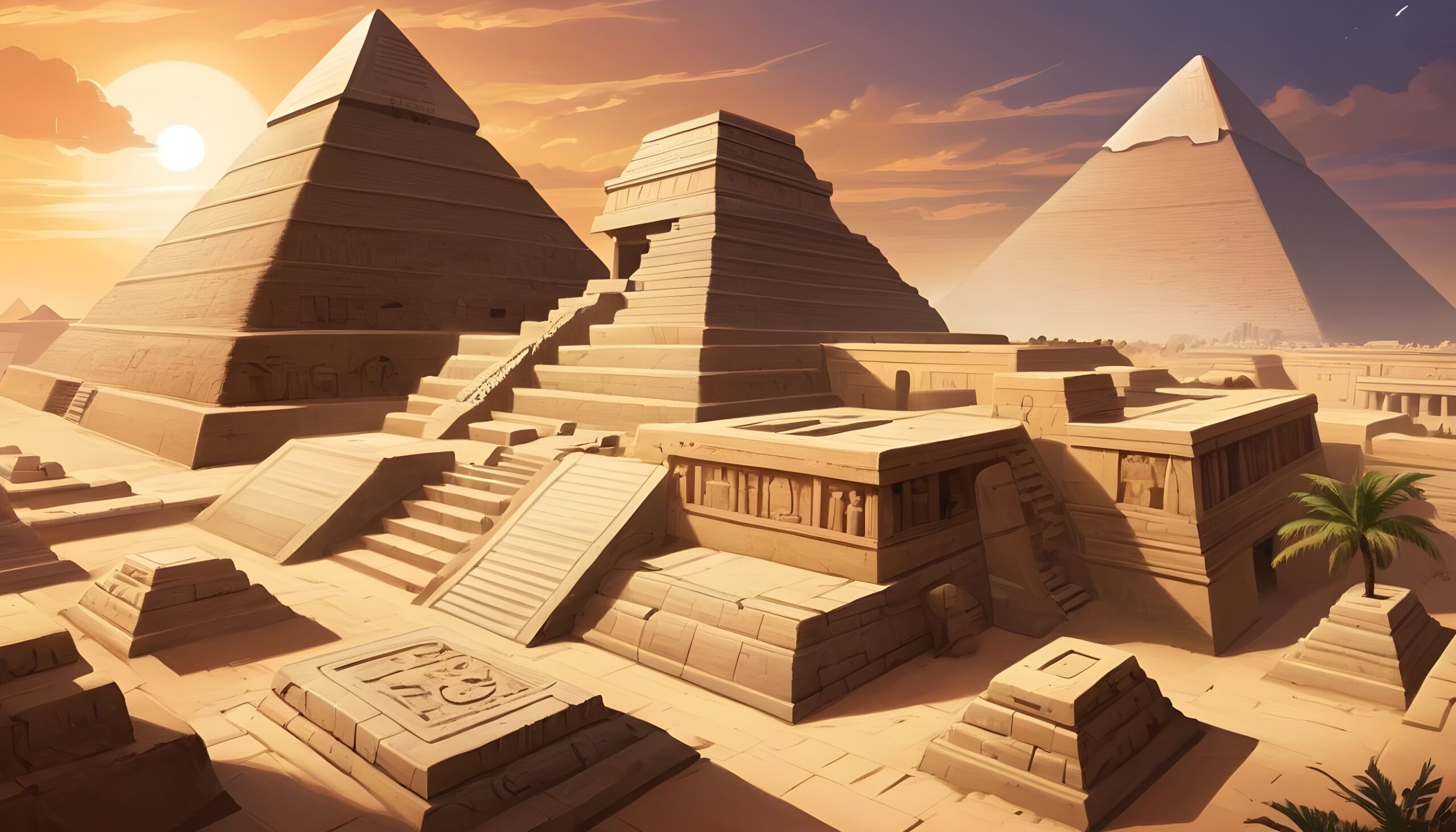In ancient times, Egypt stood as one of the world’s most remarkable civilizations, leaving behind an enduring legacy that continues to captivate the imagination of people around the globe. Nestled along the fertile banks of the Nile River, this ancient land witnessed the rise and fall of mighty dynasties, the construction of awe-inspiring monuments, and the flourishing of a rich and complex culture that has fascinated scholars and enthusiasts for centuries.
At the heart of Egypt’s allure are its iconic pyramids, towering monuments that have stood the test of time as enduring symbols of the civilization’s ingenuity and architectural prowess. From the majestic Great Pyramid of Giza, built for Pharaoh Khufu, to the enigmatic Sphinx guarding the plateau, these structures serve as eternal reminders of the ancient Egyptians’ reverence for the afterlife and their unwavering belief in the power of the pharaohs.
But Egypt’s wonders extend far beyond its monumental tombs. The civilization’s intricate writing system, hieroglyphics, adorns the walls of temples and tombs, providing a window into the beliefs, history, and daily life of ancient Egyptians. Deciphering this complex script has unlocked a wealth of knowledge about the civilization, allowing us to delve deeper into its mysteries and unravel its secrets.
Central to ancient Egyptian society was the figure of the pharaoh, revered as a divine ruler endowed with godlike powers. From the legendary King Menes, who united Upper and Lower Egypt in the early dynastic period, to the illustrious Queen Cleopatra, who famously aligned herself with Julius Caesar and Mark Antony, Egypt’s pharaohs left an indelible mark on history. Their reigns were marked by grandiose building projects, ambitious military campaigns, and intricate religious rituals that sustained the kingdom’s cosmic order.
Religion played a central role in ancient Egyptian life, permeating every aspect of society. The pantheon of gods and goddesses, including powerful deities such as Ra, Osiris, and Isis, was worshipped with fervent devotion. Ra, the sun god, symbolized light, warmth, and life, while Osiris, god of the afterlife, presided over the realm of the dead, guiding souls to their final resting place. Isis, the goddess of magic and motherhood, was revered as the protector of the pharaoh and the people, embodying the nurturing and protective aspects of femininity.
One of the most intriguing aspects of ancient Egyptian culture is the practice of mummification, a sacred ritual performed on the deceased to ensure their safe passage into the afterlife. This elaborate process involved the careful removal of organs, preservation of the body with natron salts, and wrapping in linen bandages. Tombs filled with treasures and offerings were prepared to sustain the deceased in eternity, reflecting the Egyptians’ belief in the continuity of life beyond death.
Despite its enduring legacy, ancient Egypt eventually succumbed to the passage of time and the pressures of external forces. The decline of the New Kingdom marked the beginning of a tumultuous period characterized by foreign invasions, internal strife, and the eventual conquest of Egypt by Alexander the Great in 332 BCE. Subsequent rule by the Ptolemies and the Romans marked the end of native Egyptian rule and the beginning of a new chapter in the country’s history.
Yet, the legacy of ancient Egypt lives on, as timeless reminders of a civilization that shaped the course of history and continues to inspire wonder and fascination to this day. From the banks of the Nile to the sands of the desert, the echoes of Egypt’s ancient wonders continue to captivate the imagination, inviting us to embark on a journey through the sands of time to uncover the secrets of this enigmatic civilization.
The Rise of Ancient Egypt
The story of ancient Egypt is a tale that spans over 5,000 years, tracing its origins to the banks of the Nile River where one of the world’s most remarkable civilizations emerged. It all began with the unification of Upper and Lower Egypt under the reign of King Menes, a legendary figure credited with establishing the foundations of Egypt’s first dynasty. This pivotal event, which occurred around 3100 BCE, marked the dawn of a new era known as the Old Kingdom period.
Under the rule of King Menes, Egypt underwent a period of unprecedented political stability and cultural flourishing. The land was divided into two distinct regions—Upper Egypt to the south, and Lower Egypt to the north—each with its own traditions and rulers. However, it was Menes who succeeded in uniting these disparate kingdoms into a single entity, forging a powerful centralized state that would endure for millennia.
It was during the Old Kingdom period that Egypt witnessed the construction of some of its most iconic monuments—the pyramids. These colossal structures, built as monumental tombs for the pharaohs, stand as enduring symbols of Egypt’s grandeur and architectural prowess. The Great Pyramid of Giza, built for Pharaoh Khufu, is perhaps the most famous of these structures, a marvel of engineering that continues to inspire awe and wonder to this day.
The pharaohs of ancient Egypt were more than mere mortal rulers—they were revered as god-kings endowed with divine authority. Believed to be the earthly manifestations of the gods themselves, the pharaohs were entrusted with the responsibility of maintaining order and harmony in the kingdom. They presided over a vast bureaucracy that managed the affairs of state, overseeing monumental building projects, organizing trade expeditions, and conducting religious rituals to appease the gods.
Religion played a central role in ancient Egyptian society, permeating every aspect of life. The pantheon of gods and goddesses was vast and diverse, with each deity serving a specific function and embodying different aspects of the natural world. Chief among these gods was Ra, the sun god, who was worshipped as the supreme deity and creator of all life. Osiris, god of the afterlife and resurrection, played a crucial role in Egyptian funerary beliefs, while Isis, goddess of magic and motherhood, was revered as the protector of the pharaoh and the people.
The Old Kingdom period is often regarded as the golden age of ancient Egypt, a time of prosperity, stability, and cultural achievement. However, like all great civilizations, Egypt experienced periods of decline and upheaval. The Old Kingdom eventually gave way to the First Intermediate Period, a turbulent era marked by political fragmentation, economic instability, and social unrest. Yet, despite these challenges, the legacy of ancient Egypt endured, laying the foundation for the remarkable civilization that would emerge in the centuries to come.
The Pyramids: Marvels of Ancient Engineering
The pyramids of Egypt stand as timeless marvels, monuments to the ingenuity and ambition of one of history’s greatest civilizations. Among these monumental structures, those at Giza are perhaps the most renowned, capturing the imagination of people worldwide with their sheer size, precision, and enigmatic allure. At the forefront stands the Great Pyramid of Giza, built for Pharaoh Khufu, a testament to ancient Egypt’s mastery of engineering and craftsmanship.
Constructed over 4,500 years ago, the Great Pyramid is the largest and most famous of the Egyptian pyramids, towering over the Giza plateau with imposing grandeur. Rising to a height of approximately 481 feet (146 meters), it held the title of the tallest man-made structure in the world for over 3,800 years—a feat that speaks to the remarkable skill and determination of its builders.
The construction of the pyramids was a monumental undertaking, requiring the coordination of thousands of laborers, engineers, and artisans over the course of several decades. Using only simple tools such as copper chisels, wooden sledges, and ropes, these ancient craftsmen hewed massive blocks of limestone and granite from quarries located miles away, transporting them across the desert sands to the construction site.
What truly sets the pyramids apart, however, is their precise architectural design and alignment. Despite their immense size, the pyramids exhibit remarkable geometric symmetry and accuracy, a testament to the advanced mathematical and engineering knowledge of the ancient Egyptians. The sides of the Great Pyramid are aligned almost perfectly with the cardinal points of the compass, with only a few fractions of a degree of error—a feat that continues to baffle modern scholars and engineers.
The purpose of the pyramids, while shrouded in mystery, is believed to be primarily funerary in nature. These monumental structures served as tombs for the pharaohs, containing vast chambers and passageways intended to safeguard the ruler’s body and possessions for eternity. Within the inner chambers of the Great Pyramid, archaeologists discovered the remains of Khufu’s burial chamber, along with precious artifacts and inscriptions that shed light on ancient Egyptian funerary beliefs.
Central to these beliefs was the concept of the afterlife, wherein the soul of the deceased would embark on a journey to the realm of the gods. The construction of the pyramids was seen as a means of ensuring the pharaoh’s safe passage into the afterlife, providing him with a grand and eternal resting place befitting his divine status. Elaborate rituals and ceremonies accompanied the burial process, including the mummification of the pharaoh’s body and the placement of valuable treasures and offerings within the tomb.
The enduring legacy of the pyramids extends far beyond their physical presence on the Giza plateau. They serve as enduring symbols of ancient Egypt’s cultural and spiritual heritage, embodying the civilization’s profound reverence for the divine and its unwavering belief in the continuity of life beyond death. As enduring monuments to human achievement and ambition, the pyramids continue to inspire awe and wonder, inviting us to ponder the mysteries of the past and marvel at the enduring legacy of one of history’s greatest civilizations.
Pharaohs: Divine Rulers of the Land
The pharaohs of ancient Egypt reigned as divine monarchs, wielding both political power and religious authority over their kingdom. At the apex of Egyptian society, they were revered as living gods, entrusted with the sacred duty of upholding Ma’at—the cosmic order that governed the universe. As the intermediaries between the gods and the people, the pharaohs played a pivotal role in maintaining harmony and prosperity within the kingdom.
Central to the pharaoh’s authority was the belief in their divine lineage. According to Egyptian mythology, the pharaohs were believed to be direct descendants of the gods, with their rule sanctioned by divine mandate. This divine connection imbued the pharaoh with unparalleled prestige and authority, elevating them above ordinary mortals and granting them the right to rule with absolute power.
The pharaoh’s role was multifaceted, encompassing both secular and religious duties. As the political leader of the kingdom, the pharaoh wielded supreme authority over matters of governance, administration, and law. They presided over a vast bureaucracy that managed the affairs of state, overseeing everything from taxation and trade to public works and foreign relations.
In addition to their political responsibilities, the pharaohs also served as the primary religious figures within Egyptian society. They were seen as the earthly representatives of the gods, responsible for maintaining divine favor and ensuring the spiritual well-being of the kingdom. Through elaborate rituals and ceremonies, the pharaohs sought to appease the gods and secure their blessings for the prosperity and fertility of the land.
Throughout Egypt’s long history, dynasties rose and fell, each leaving its own mark on the annals of history. Some pharaohs, such as Ramses II, achieved legendary status through their military conquests, monumental building projects, and prolific patronage of the arts. Known as Ramses the Great, he ruled for over six decades during the New Kingdom period, leaving behind a legacy of grandeur and power that endured for centuries.
Other pharaohs, such as Tutankhamun, became famous not for the length of their reigns but for the remarkable treasures they left behind. Tutankhamun, whose tomb was discovered virtually intact in the Valley of the Kings, became a household name around the world due to the stunning riches and artifacts found within his burial chamber. Despite ruling for a relatively short time, Tutankhamun’s reign has captured the imagination of historians and Egyptologists for generations.
Yet, for all their power and prestige, the pharaohs were not immune to the passage of time and the inevitability of mortality. As mortal beings, they faced the same trials and tribulations as their subjects, confronting challenges both internal and external. From political intrigue and palace intrigue to foreign invasions and economic upheaval, the pharaohs navigated a tumultuous landscape fraught with peril and uncertainty.
In the end, the legacy of the pharaohs endures as a testament to the enduring spirit of ancient Egypt. Through their wisdom, strength, and divine mandate, they guided their kingdom through the ages, leaving behind a legacy of grandeur and majesty that continues to captivate the imagination of people around the world. As the divine rulers of the land, the pharaohs embodied the essence of Egyptian civilization, standing as immortal symbols of power, prestige, and authority.
Hieroglyphics: Language of the Gods
Hieroglyphics, the ancient Egyptian writing system, served as the cornerstone of communication and record-keeping for one of the world’s most enduring civilizations. With its intricate symbols and pictograms, hieroglyphs adorned the walls of temples and tombs, preserving the stories, beliefs, and achievements of ancient Egypt for millennia. From tales of mythology and epic battles to detailed records of daily life and religious ceremonies, hieroglyphs provided a window into the rich tapestry of Egyptian culture and society.
The origins of hieroglyphic writing can be traced back to the predynastic period, around 3300 BCE, when ancient Egyptians first began to inscribe symbols on pottery and artifacts. Over time, this primitive form of writing evolved into a complex system of ideographic and phonetic symbols, encompassing over 700 distinct characters by the time of the Old Kingdom. Hieroglyphs were used for a variety of purposes, including monumental inscriptions, administrative documents, religious texts, and personal correspondence.
At the heart of hieroglyphic writing was its symbolic nature, with each glyph representing a specific word, concept, or sound. Some hieroglyphs were straightforward pictograms, depicting objects or animals, while others were more abstract, representing ideas or abstract concepts. The intricate combination of symbols allowed ancient Egyptians to convey complex thoughts and narratives with remarkable precision and nuance.
Deciphering the secrets of hieroglyphic writing proved to be a monumental challenge for scholars and linguists for centuries. The script had been lost to history following the decline of ancient Egypt, and its meaning remained a mystery to the outside world. It wasn’t until the early 19th century that significant strides were made in deciphering hieroglyphs, thanks to the pioneering efforts of scholars such as Jean-François Champollion.
Champollion, a French philologist and linguist, made a breakthrough discovery in 1822 when he successfully deciphered the hieroglyphic inscription on the Rosetta Stone—a decree issued by King Ptolemy V in 196 BCE. By comparing the Greek text of the decree with the hieroglyphic and demotic scripts, Champollion was able to identify key phonetic clues and unlock the meaning of the hieroglyphic symbols.
Through his meticulous research and analysis, Champollion laid the groundwork for the modern understanding of hieroglyphic writing, opening up a treasure trove of knowledge about ancient Egypt. His groundbreaking work paved the way for further discoveries and advancements in the field of Egyptology, allowing scholars to interpret and translate countless inscriptions, texts, and artifacts from antiquity.
Today, hieroglyphic writing stands as a testament to the enduring legacy of ancient Egypt, a civilization that flourished for thousands of years along the banks of the Nile River. While the spoken language of the ancient Egyptians has long been extinct, their written legacy lives on through the intricate symbols and pictograms that adorn temples, tombs, and monuments across the land. As we continue to unlock the secrets of hieroglyphic writing, we gain a deeper understanding of the rich and vibrant culture that once thrived in the land of the pharaohs.
Religion: Worship of Ra, Osiris, and Isis
Central to the vibrant tapestry of ancient Egyptian religion was a rich pantheon of gods and goddesses, each with their own distinct domains and attributes. Among these deities, three figures held particularly prominent roles in the religious beliefs and practices of the ancient Egyptians: Ra, Osiris, and Isis.
At the pinnacle of the Egyptian pantheon stood Ra, the powerful sun god and creator deity. Ra was revered as the divine embodiment of the sun, symbolizing light, warmth, and life. As the sun traversed the sky each day, it was believed to be Ra’s journey through the heavens, bringing light and vitality to the world. Ra’s radiance illuminated the earth, nourishing crops, sustaining life, and dispelling darkness. The worship of Ra was central to Egyptian cosmology, with temples and cults dedicated to his honor found throughout the land.
Another key figure in Egyptian religion was Osiris, the god of the afterlife and resurrection. Osiris played a central role in Egyptian funerary beliefs, serving as the divine judge and ruler of the underworld. According to myth, Osiris was murdered by his jealous brother Set, but was later resurrected by his wife Isis, symbolizing the cyclical nature of death and rebirth. Osiris was venerated as the protector of the dead, guiding souls through the perilous journey to the afterlife and presiding over their judgment in the Hall of Ma’at.
Isis, the goddess of magic and motherhood, was revered as one of the most beloved and compassionate deities in the Egyptian pantheon. As the wife of Osiris and the mother of Horus, Isis embodied the nurturing and protective aspects of femininity. She was worshipped as the patroness of women, children, and families, and was believed to possess great magical powers. According to myth, Isis used her magical abilities to resurrect Osiris and protect her son Horus from harm, earning her the devotion and reverence of the Egyptian people.
Together, Ra, Osiris, and Isis formed a triad of deities that played a central role in the religious life of ancient Egypt. Their worship permeated every aspect of Egyptian society, from grand temple rituals to personal prayers and offerings. The beliefs and rituals associated with these gods provided comfort, guidance, and meaning to the lives of the ancient Egyptians, shaping their worldview and influencing their cultural practices for millennia. Even today, the enduring legacy of Ra, Osiris, and Isis continues to captivate the imagination and inspire awe and wonder in people around the world.
Mummification: Journey to the Afterlife
The ancient Egyptians held a profound belief in the afterlife, viewing death not as an end, but as a transition to a new existence beyond the mortal realm. Central to their funerary practices was the process of mummification—a sacred ritual performed on the deceased to ensure their safe passage into the next life. This meticulous and complex procedure was imbued with deep religious significance, reflecting the Egyptians’ belief in the preservation of the soul and the body for eternity.
The process of mummification began with the careful preparation of the deceased’s body, typically carried out by skilled embalmers known as “wrappers of the dead.” The first step involved the removal of internal organs, a process known as evisceration, to prevent the body from decaying rapidly. The brain was extracted through the nostrils using a hooked instrument, while the internal organs, such as the liver, lungs, stomach, and intestines, were removed and preserved separately in canopic jars.
Once the organs were removed, the body was thoroughly cleansed and purified with a mixture of natron salts—a naturally occurring substance found in the deserts of Egypt. Natron acted as a desiccant, absorbing moisture from the body and inhibiting the growth of bacteria and fungi, thereby aiding in the preservation process. The body was then packed with natron and left to dry for several weeks, ensuring that all moisture was removed before the final stages of mummification.
After the body had been thoroughly desiccated, it was carefully wrapped in linen bandages, a process that could take several days to complete. The wrappings were adorned with magical amulets and charms, intended to protect the deceased on their journey to the afterlife and ward off evil spirits. The face of the deceased was often covered with a lifelike mask, crafted from gold or painted wood, to ensure their identity was preserved in the next life.
Throughout the mummification process, elaborate rituals and prayers were performed to honor the deceased and invoke the blessings of the gods. Priests chanted hymns and incantations, while offerings of food, drink, and precious objects were placed in the tomb to sustain the deceased in eternity. The tomb itself was filled with treasures and provisions for the afterlife, including furniture, clothing, jewelry, and even pets, to ensure the comfort and well-being of the deceased in the next life.
The belief in the afterlife was central to Egyptian society, shaping every aspect of daily life and cultural practice. For the ancient Egyptians, death was not an end, but a transition to a new existence—an eternal journey that required careful preparation and ritualistic observance. Through the process of mummification, the Egyptians sought to ensure the preservation of the soul and the body, enabling the deceased to embark on a journey to the afterlife with confidence and dignity. As enduring symbols of this ancient belief system, the mummies of Egypt continue to captivate the imagination and inspire wonder in people around the world, offering a glimpse into the profound mysteries of life, death, and the human spirit.
The Fall of Ancient Egypt
The legacy of ancient Egypt is one of enduring grandeur and unparalleled cultural achievement. However, like all great civilizations, its eventual decline was inevitable, marked by a tumultuous period of upheaval and transformation. The fall of ancient Egypt was a complex process influenced by a myriad of factors, including internal strife, external invasions, and shifting power dynamics on the world stage.
The decline of ancient Egypt can be traced back to the end of the New Kingdom, a period of unprecedented prosperity and territorial expansion. By the late 12th century BCE, the kingdom had reached its zenith under the rule of powerful pharaohs such as Ramses II, who presided over a vast empire stretching from the Nile Delta to the Euphrates River. However, this golden age was not to last, as internal divisions and external threats began to erode Egypt’s power and influence.
One of the key factors contributing to the decline of ancient Egypt was internal strife and political instability. As the New Kingdom weakened, the centralized authority of the pharaohs began to wane, leading to a period of fragmentation and civil unrest. Regional governors and local leaders began to assert their independence, challenging the authority of the central government and plunging the kingdom into a state of disarray.
External pressures also played a significant role in the decline of ancient Egypt. Throughout its history, Egypt faced numerous invasions and incursions from foreign powers seeking to exploit its wealth and strategic location. The emergence of powerful empires such as the Assyrians, Persians, and Greeks posed a formidable threat to Egyptian sovereignty, culminating in the conquest of Egypt by Alexander the Great in 332 BCE.
The conquest of Egypt by Alexander the Great marked the end of native Egyptian rule and the beginning of a new chapter in the country’s history. Although Alexander’s conquest brought about a period of cultural exchange and Hellenization, it also signaled the decline of Egypt as an independent political entity. Following Alexander’s death, Egypt came under the rule of the Ptolemaic dynasty, a line of Macedonian Greek rulers who established a new dynasty that would govern Egypt for nearly three centuries.
Under Ptolemaic rule, Egypt experienced a period of relative stability and prosperity, characterized by economic growth, urban development, and cultural flourishing. However, this period was not without its challenges, as the Ptolemaic rulers struggled to maintain control over their vast and diverse kingdom. Internal rivalries and conflicts among the ruling elite, as well as external threats from neighboring powers, eventually weakened the Ptolemaic dynasty and paved the way for its eventual downfall.
The end of the Ptolemaic dynasty came with the conquest of Egypt by the Roman Empire in 30 BCE. Following the defeat of Cleopatra VII and her lover Mark Antony at the Battle of Actium, Egypt was incorporated into the vast Roman Empire as a province, marking the end of ancient Egyptian independence and the beginning of a new era of Roman rule.
Despite its eventual decline, the legacy of ancient Egypt continues to endure as a testament to human achievement and ingenuity. From the majestic pyramids to the enigmatic hieroglyphics, from the legendary pharaohs to the intricate rituals of mummification, the wonders of ancient Egypt continue to captivate the imagination and inspire awe and wonder in people around the world. As we reflect on the rise and fall of this remarkable civilization, we are reminded of the enduring legacy of one of history’s greatest civilizations, whose contributions to art, science, and culture continue to resonate to this day.
Legacy of Ancient Egypt
The legacy of ancient Egypt transcends the bounds of time, leaving an indelible mark on human history that continues to captivate and inspire generations. Despite the passage of millennia, the achievements and cultural contributions of this remarkable civilization endure as enduring testaments to human ingenuity, creativity, and resilience.
At the heart of ancient Egypt’s legacy are its iconic pyramids, towering monuments that stand as enduring symbols of the civilization’s architectural prowess and engineering mastery. From the majestic Great Pyramid of Giza to the lesser-known structures scattered along the banks of the Nile, these colossal edifices serve as reminders of Egypt’s grandeur and splendor. Built as monumental tombs for the pharaohs, the pyramids continue to fascinate scholars and enthusiasts alike, offering glimpses into the ancient Egyptians’ beliefs about the afterlife and their reverence for the divine.
Another enduring legacy of ancient Egypt is its intricate writing system, hieroglyphics, which continue to intrigue and mystify scholars and enthusiasts alike. Carved into the walls of temples and tombs, hieroglyphs provide a window into the beliefs, history, and daily life of ancient Egyptians. Deciphering this complex script has unlocked a wealth of knowledge about the civilization, shedding light on its religious beliefs, political institutions, and cultural practices. From tales of gods and goddesses to records of monumental achievements, hieroglyphics offer invaluable insights into the rich tapestry of ancient Egyptian society.
Central to the enduring legacy of ancient Egypt are the stories of its pharaohs, who ruled as divine monarchs and left an indelible mark on history. From legendary figures like Ramses II, who built vast temples and monuments, to lesser-known rulers like Hatshepsut, who defied tradition to ascend the throne, the pharaohs of ancient Egypt continue to capture the imagination with their tales of power, glory, and ambition. Their reigns were marked by grandiose building projects, ambitious military campaigns, and intricate religious rituals that sustained the kingdom’s cosmic order.
Religion played a central role in ancient Egyptian life, permeating every aspect of society and leaving an enduring legacy that continues to resonate to this day. The pantheon of gods and goddesses, including powerful deities such as Ra, Osiris, and Isis, was worshipped with fervent devotion, with temples and cults dedicated to their honor found throughout the land. The religious beliefs and rituals of ancient Egypt shaped every aspect of daily life, from birth to death, providing a framework for understanding the mysteries of the cosmos and the human condition.
As we reflect on the legacy of ancient Egypt, we are reminded of the enduring impact of this remarkable civilization on the course of human history. From its monumental architecture to its intricate art and literature, ancient Egypt continues to inspire awe and wonder, inviting us to delve deeper into its mysteries and unravel its secrets. The legacy of ancient Egypt lives on, as timeless reminders of a civilization that shaped the course of history and continues to captivate the imagination of people around the world.










More Stories
Victorian Era: Society, Culture, and Values in 19th-Century Britain
Transforming Society in the 19th Century
From Haymarket to Global Solidarity: The History of Labour Day